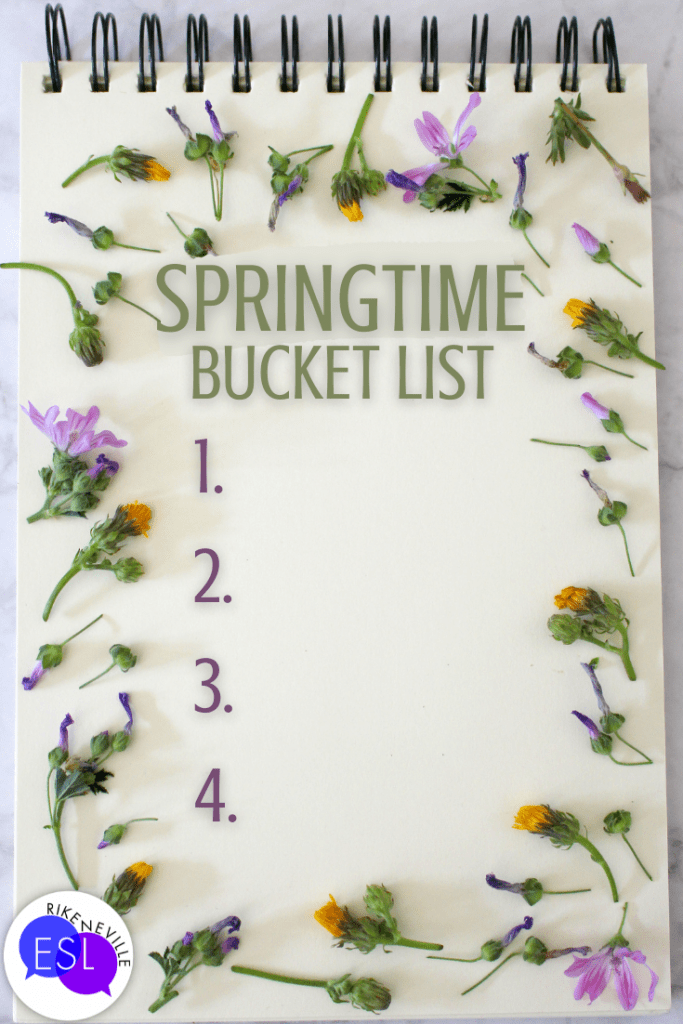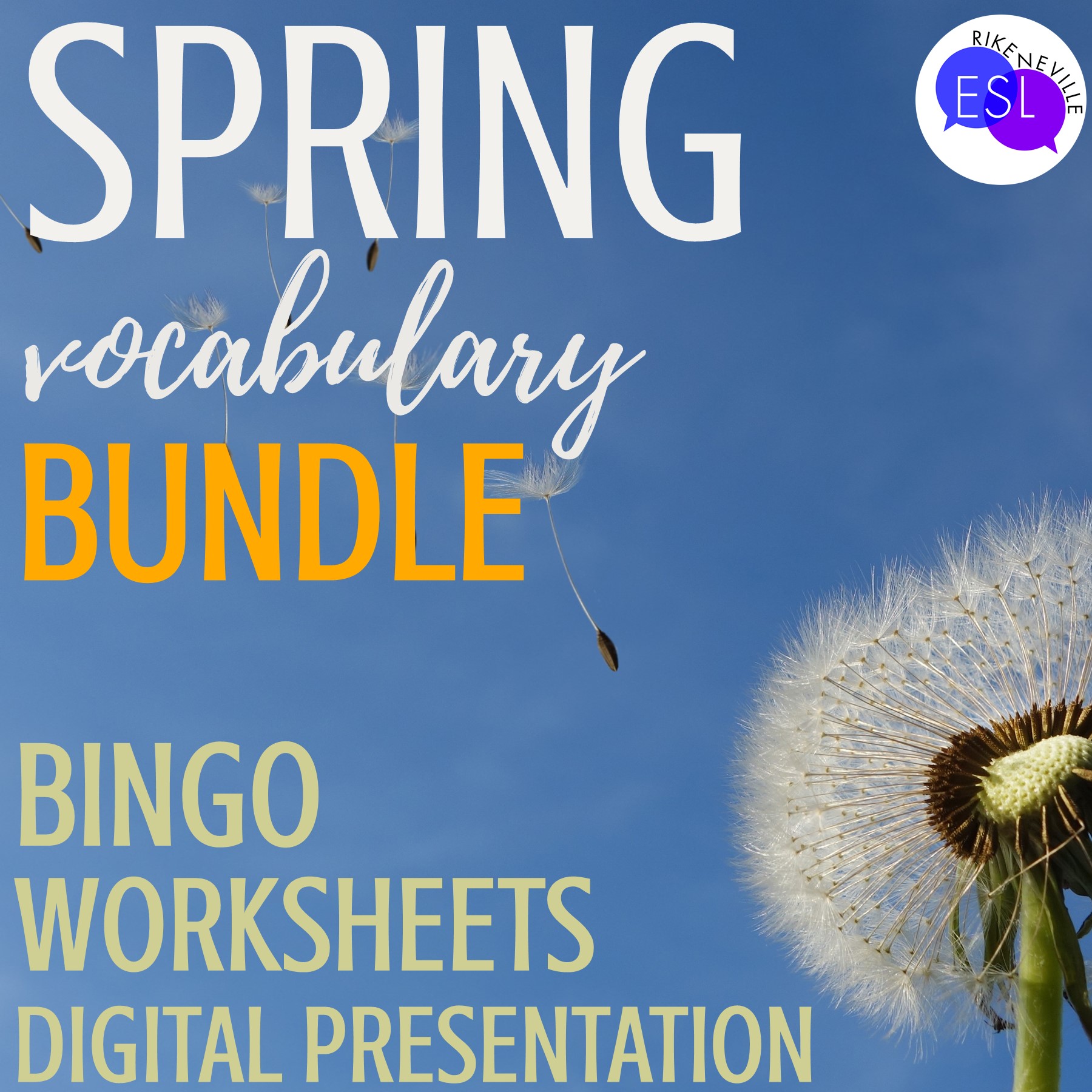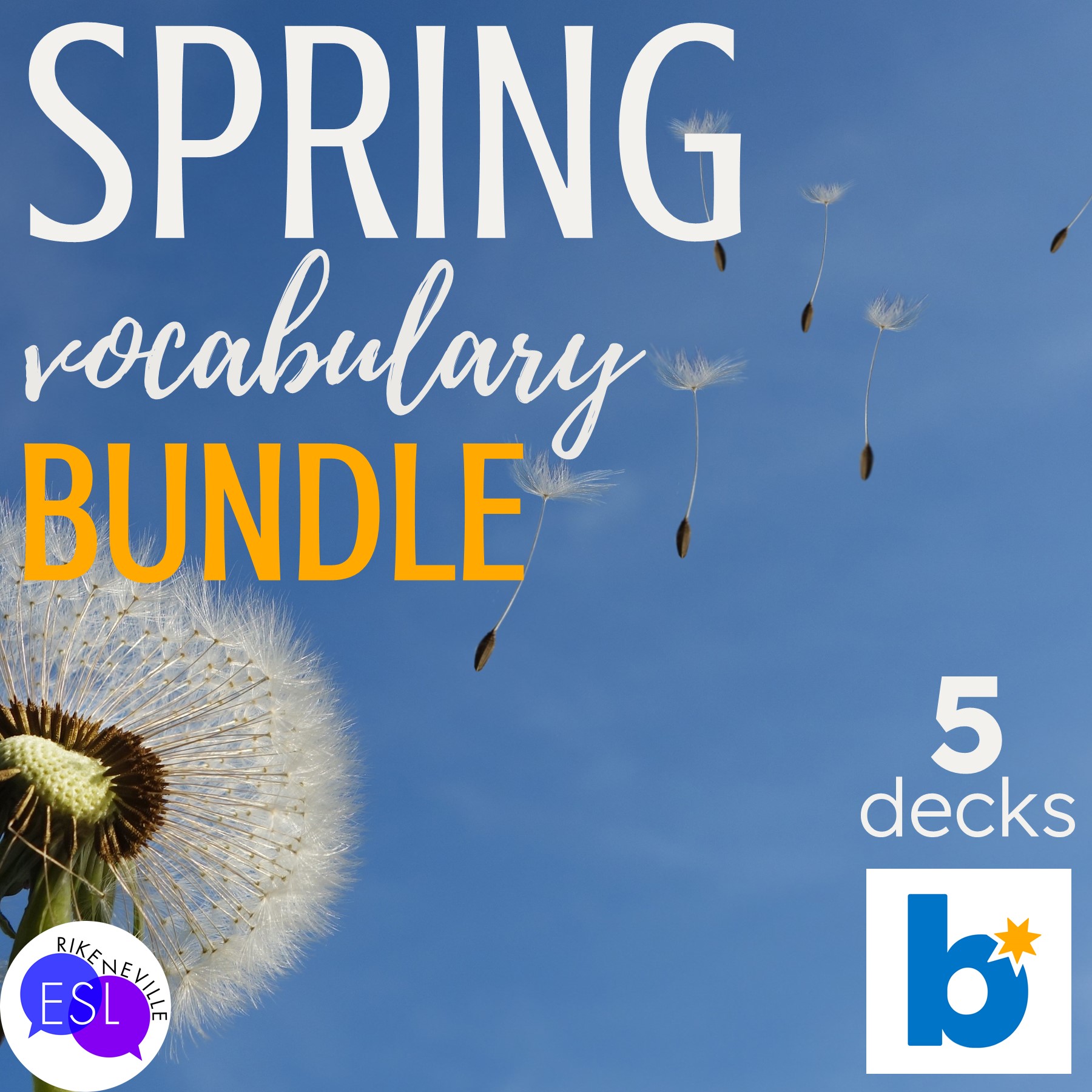
The days are (finally) getting longer and you want to shake off the winter doldrums your adult ESL students are mired in. Embrace the springtime with activities that will engage and delight your students!
Spring-flavored activities for adult ESL
springtime activities: Make It Local
Introduce them to some activities that are commonly enjoyed in the spring that are specific to your area. With daytime temperatures becoming more friendly towards outdoor activities, everyone will likely want to spend some time outside. The activities they are accustomed to enjoying in their native countries might not be available where they are now, so let them know about any local events such as arts festivals, parades, and marathons. Share some sweet camping spots, talk about yard sales, and make sure they know of any nearby state or national parks. Of course, you’ll also want to get conversations going about springtime activities in THEIR countries.

springtime activities: Idioms Related to Spring
I’ve never had a class turn down the chance to learn some new idioms, and spring is the perfect time to break out idioms such as take a hike or go fly a kite. They’re literally great springtime activities, but their idiomatic meaning will give these phrases a different flavor. Of course, if your students have (or want to have) a green thumb, teach them which seeds are best for your area so they can start some seedlings and later plant a spring garden. Even if you are no spring chicken, you’ll have an easier time dealing with their spring fever and getting them to spring to attention when you have a lesson on spring-related idioms.
springtime activities: Spring Infusion
Infuse every lesson with a spring theme. You can add the scent of spring to grammar, writing, speaking, and more!
- Teaching prepositions of location or directions? Get some maps for them to plot out routes to any local you-pick berry farms.
- Working with descriptive language/adjectives? Give them descriptions of local birds and challenge them to notice and take pictures of the birds.
- Teaching step-by-step directions? Write instructions for how to hang a birdhouse, cut up the instructions into strips, and have students sequence them.
- If health is a topic or theme, it might be beneficial to bring up springtime allergies. You can talk about symptoms and causes as well as teach them some generic terms for allergy medicine (and talk about side effects).
- Working on weather vocabulary? What better time to ensure they know what to do when there is a tornado than in the spring?
Use your creativity, and you’ll find ways to infuse almost anything with a fresh breath of spring! If you are looking for spring vocabulary resources, how about a digital presentation that introduces it, a bingo game that reviews it, or worksheets that reinforce it?
springtime activities: The Spring Scavenger Hunt
While they might moan and groan a bit when you ask them to do something as “strenuous” as moving to another seat, tell them that you are going to send them outside, and they will get their sluggish blood moving without much prodding at all. My students LOVED going on campus-wide scavenger hunts. I’d put them in mixed native language groups (when possible), give them a list of things to look for and photograph, give them a deadline for returning, and turn them loose.
Some items on your scavenger hunt might include: the feet of someone wearing sandals, a robin, a daffodil, dandelions, someone making a dandelion wish, and an umbrella (whether in-use or not). Include videos and you can have them asking people to define spring-related idioms, name their favorite spring flower, or talk about their favorite springtime activity.
Many of my students were very eager to try speaking in English with others but shied away from doing so because they didn’t have a purpose. With their scavenger hunt list in hand, walking up to random strangers to ask them questions became easy as they could always roll their eyes and blame it on me.

springtime activities: Spring Bucket List
Once you have discussed spring and had them try a few spring activities, try this writing activity. Have them write out their Spring Bucket List of activities they want to try.
Whether it’s a simple list, you require them to explain why for each item, or you have them create a plan for actually doing one or more activities, they’ll have spring on their minds while practicing their English.
If you don’t want the possibility of them associating a spring bucket list with things to do before dying, you could alternatively call this the Dandelion Wish List.

springtime activities: DST Debate
Daylight Saving Time tends to be a fairly hot topic around this time of year. No one really argues with getting that extra hour of sleep in the fall, but losing it in the spring? That’s when DST is suddenly all over the news. Divide students into teams or partners and assign each to debate for or against DST, keeping only DST, or keeping only standard time.
springtime activities: April Fool’s Day
Adult ESL students usually LOVE to read and talk about pranks, the bigger the better. They’ll likely answer reading comprehension questions willingly enough, but if the text is on some classic April Fool’s jokes, they’re going to be much more engaged with the story.
Yes, the big stories about large companies playing pranks, the part the media plays in enlarging the audience of a joke, and any stories of a prank going horribly wrong will be read with a lot of glee and probably some disbelief that anyone fell for it, but absolutely share that time your family got you good. Tell them about when you totally fooled a class in the past. Ask THEM about jokes they’ve played and pranks they’ve pulled, not just on April Fool’s Day, but any day.

For extra fun, brainstorm some pranks your class can play on other classes!
springtime activities: Spring Break Destinations
Spring break destinations is an especially fun presentation topic that has practical use. Have your students sign up for a destination to ensure that each destination is unique. Have students research and plan an imaginary trip to their destination of choice. Encourage them to think about how to get there (the route, the amount of time it will take, any costs involved, etc.), where to stay (specific hotels, hostels, etc. along with room rates), must-see sights, must-try restaurants, activities, and anything else they can think of. They can also find and share photos to whet everyone’s desire for that destination. Most people love to travel, so it’s a safe bet that the audience will be fully engaged during each presentation.
If possible, bring up having a class picnic. This lends itself well to class discussions on where and when to go, what food to bring, what activities to plan for (and what to bring for those activities, whether or not to include family members, how long it should last, how to handle any transportation needs, etc. Then there is the picnic itself–a fine opportunity to build stronger ties in your classroom and tons of chances for people to practice the English they’ve learned (even if it’s only introducing family members they’ve brought).

springtime activities: Be Punny
Puns are likely too much for your lower-level students because humor dissipates the longer it takes to explain why something is funny. Your upper-intermediate to advanced students will get more laughs from a quick lesson on springtime puns or having them injected anywhere you can.
Mentioning anything about gardening? The gardeners were so excited about spring that they wet their plants. Have a unit on occupations? What did the florist say when it was springtime? Business is blooming! Any discussions on flowers? Why couldn’t the flower ride a bike? It lost its petals. Grammar class? What month always asks questions and permission? May! Want to combine puns with an idioms lesson? How can you tell the weather is getting warmer? There’s a spring in everyone’s step!
How will you celebrate spring in your classroom?
Remember, observing and celebrating the seasons cultivates gratitude and gives us something to hold onto so we don’t drown in the sameness that routines of the rat race force on us. Breaking up the year into seasons can help stop time from jumping every time we blink, where somehow the days drag on forever but the months flash by so fast we can’t remember anything significant happening. It transforms the normal ordinary into something special. Make that a part of your lessons and a part of your students’ lives.
Spring Resource Alert!
Love the idea of adding a touch of spring but don’t have time or the headspace to deal with any of those activities? Take a look at these bundles of spring resources created especially for adult ESL.




Leave a Reply